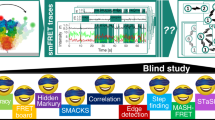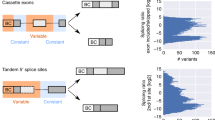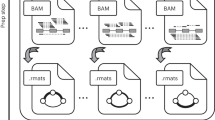Abstract
We report Single Molecule Cluster Analysis (SiMCAn), which utilizes hierarchical clustering of hidden Markov modeling–fitted single-molecule fluorescence resonance energy transfer (smFRET) trajectories to dissect the complex conformational dynamics of biomolecular machines. We used this method to study the conformational dynamics of a precursor mRNA during the splicing cycle as carried out by the spliceosome. By clustering common dynamic behaviors derived from selectively blocked splicing reactions, SiMCAn was able to identify the signature conformations and dynamic behaviors of multiple ATP-dependent intermediates. In addition, it identified an open conformation adopted late in splicing by a 3′ splice-site mutant, invoking a mechanism for substrate proofreading. SiMCAn enables rapid interpretation of complex single-molecule behaviors and should prove useful for the comprehensive analysis of a plethora of dynamic cellular machines.
This is a preview of subscription content, access via your institution
Access options
Subscribe to this journal
Receive 12 print issues and online access
$259.00 per year
only $21.58 per issue
Buy this article
- Purchase on Springer Link
- Instant access to full article PDF
Prices may be subject to local taxes which are calculated during checkout






Similar content being viewed by others
References
Pitchiaya, S., Heinicke, L.A., Custer, T.C. & Walter, N.G. Single molecule fluorescence approaches shed light on intracellular RNAs. Chem. Rev. 114, 3224–3265 (2014).
Mustoe, A.M., Brooks, C.L. & Al-Hashimi, H.M. Hierarchy of RNA functional dynamics. Annu. Rev. Biochem. 83, 441–466 (2014).
Al-Hashimi, H.M. & Walter, N.G. RNA dynamics: it is about time. Curr. Opin. Struct. Biol. 18, 321–329 (2008).
Cruz, J.A. & Westhof, E. The dynamic landscapes of RNA architecture. Cell 136, 604–609 (2009).
Krishnan, R. et al. Biased Brownian ratcheting leads to pre-mRNA remodeling and capture prior to first-step splicing. Nat. Struct. Mol. Biol. 20, 1450–1457 (2013).
Abelson, J. et al. Conformational dynamics of single pre-mRNA molecules during in vitro splicing. Nat. Struct. Mol. Biol. 17, 504–512 (2010).
Blanco, M. & Walter, N.G. Analysis of complex single-molecule FRET time trajectories. Methods Enzymol. 472, 153–178 (2010).
Walter, N.G., Huang, C.Y., Manzo, A.J. & Sobhy, M.A. Do-it-yourself guide: how to use the modern single-molecule toolkit. Nat. Methods 5, 475–489 (2008).
Walter, N.G. & Bustamante, C. Introduction to single molecule imaging and mechanics: seeing and touching molecules one at a time. Chem. Rev. 114, 3069–3071 (2014).
Crawford, D.J. et al. Single-molecule colocalization FRET evidence that spliceosome activation precedes stable approach of 5′ splice site and branch site. Proc. Natl. Acad. Sci. USA 110, 6783–6788 (2013).
Brody, E. & Abelson, J. The “spliceosome”: yeast pre-messenger RNA associates with a 40S complex in a splicing-dependent reaction. Science 228, 963–967 (1985).
Egecioglu, D.E. & Chanfreau, G. Proofreading and spellchecking: a two-tier strategy for pre-mRNA splicing quality control. RNA 17, 383–389 (2011).
Semlow, D.R. & Staley, J.P. Staying on message: ensuring fidelity in pre-mRNA splicing. Trends Biochem. Sci. 37, 263–273 (2012).
Staley, J.P. & Guthrie, C. Mechanical devices of the spliceosome: motors, clocks, springs, and things. Cell 92, 315–326 (1998).
Wahl, M.C., Will, C.L. & Luhrmann, R. The spliceosome: design principles of a dynamic RNP machine. Cell 136, 701–718 (2009).
Abelson, J., Hadjivassiliou, H. & Guthrie, C. Preparation of fluorescent pre-mRNA substrates for an smFRET study of pre-mRNA splicing in yeast. Methods Enzymol. 472, 31–40 (2010).
Gopich, I.V. & Szabo, A. Theory of the energy transfer efficiency and fluorescence lifetime distribution in single-molecule FRET. Proc. Natl. Acad. Sci. USA 109, 7747–7752 (2012).
Keller, B.G. et al. Complex RNA folding kinetics revealed by single-molecule FRET and hidden Markov models. J. Am. Chem. Soc. 136, 4534–4543 (2014).
Greenfeld, M., Pavlichin, D.S., Mabuchi, H. & Herschlag, D. Single Molecule Analysis Research Tool (SMART): an integrated approach for analyzing single molecule data. PLoS One 7, e30024 (2012).
Bruno, A.E. et al. Comparing chemistry to outcome: the development of a chemical distance metric, coupled with clustering and hierarchal visualization applied to macromolecular crystallography. PLoS One 9, e100782 (2014).
Mall, R., Langone, R. & Suykens, J.A. Multilevel hierarchical kernel spectral clustering for real-life large scale complex networks. PLoS One 9, e99966 (2014).
Tibshirani, R., Walther, G. & Hastie, T. Estimating the number of clusters in a data set via the gap statistic. J. R. Stat. Soc. Series B Stat. Methodol. 63, 411–423 (2001).
Bronson, J.E. et al. Learning rates and states from biophysical time series: a Bayesian approach to model selection and single-molecule FRET data. Biophys. J. 97, 3196–3205 (2009).
Kim, S.H. & Lin, R.J. Spliceosome activation by PRP2 ATPase prior to the first transesterification reaction of pre-mRNA splicing. Mol. Cell. Biol. 16, 6810–6819 (1996).
Warkocki, Z. et al. Reconstitution of both steps of Saccharomyces cerevisiae splicing with purified spliceosomal components. Nat. Struct. Mol. Biol. 16, 1237–1243 (2009).
Koodathingal, P., Novak, T., Piccirilli, J.A. & Staley, J.P. The DEAH box ATPases Prp16 and Prp43 cooperate to proofread 5′ splice site cleavage during pre-mRNA splicing. Mol. Cell 39, 385–395 (2010).
Schneider, S., Hotz, H.R. & Schwer, B. Characterization of dominant-negative mutants of the DEAH-box splicing factors Prp22 and Prp16. J. Biol. Chem. 277, 15452–15458 (2002).
Rymond, B.C. & Rosbash, M. Cleavage of 5′ splice site and lariat formation are independent of 3′ splice site in yeast mRNA splicing. Nature 317, 735–737 (1985).
Ohrt, T. et al. Molecular dissection of step 2 catalysis of yeast pre-mRNA splicing investigated in a purified system. RNA 19, 902–915 (2013).
Umen, J.G. & Guthrie, C. Prp16p, Slu7p, and Prp8p interact with the 3′ splice site in two distinct stages during the second catalytic step of pre-mRNA splicing. RNA 1, 584–597 (1995).
Mayas, R.M., Maita, H. & Staley, J.P. Exon ligation is proofread by the DExD/H-box ATPase Prp22p. Nat. Struct. Mol. Biol. 13, 482–490 (2006).
Woese, C.R. & Fox, G.E. Phylogenetic structure of the prokaryotic domain: the primary kingdoms. Proc. Natl. Acad. Sci. USA 74, 5088–5090 (1977).
Hoskins, A.A. et al. Ordered and dynamic assembly of single spliceosomes. Science 331, 1289–1295 (2011).
Stevens, S.W. & Abelson, J. Yeast pre-mRNA splicing: methods, mechanisms, and machinery. Methods Enzymol. 351, 200–220 (2002).
Roy, R., Hohng, S. & Ha, T. A practical guide to single-molecule FRET. Nat. Methods 5, 507–516 (2008).
Widom, J.R., Dhakal, S., Heinicke, L.A. & Walter, N.G. Single-molecule tools for enzymology, structural biology, systems biology and nanotechnology: an update. Arch. Toxicol. 88, 1965–1985 (2014).
Acknowledgements
The authors thank A. Price (University of California, San Francisco) for providing native gel analysis of CC2 formation using Ubc4; D.R. Semlow and J.P. Staley (University of Chicago) for providing the dominant-negative Prp16 protein expression plasmid; N.N. Vo for compiling all Matlab scripts of SiMCAn into a GUI; and C. Guthrie, D.R. Semlow, J.P. Staley and A.A. Hoskins for providing valuable comments on the manuscript. The authors acknowledge funding from the US National Institutes of Health (grant R01GM098023 to N.G.W. and J.A.), the National Heart, Lung and Blood Institute (grant R01HL111527-01 to A.L.) and the National Science Foundation through the National Evolutionary Synthesis Center (NESCent) (grant NSF\#EF-0905606 to J.S.M.).
Author information
Authors and Affiliations
Contributions
M.L.K. and R.K. performed in vitro splicing verification assays. M.L.K. and M.R.B. performed single-molecule experiments and performed data analysis. M.L.K. expressed and purified the Prp16DN protein. M.R.B. and J.S.M. wrote and developed the Matlab scripts for SiMCAn. M.L.K. prepared all fluorescent substrates and yeast whole-cell extracts. M.R.B., J.S.M., M.L.K., J.A., A.L. and N.G.W. jointly wrote the manuscript.
Corresponding author
Ethics declarations
Competing interests
The authors declare no competing financial interests.
Supplementary information
Supplementary Text and Figures
Supplementary Figures 1–19, Supplementary Tables 1–3 and Supplementary Notes 1–5 (PDF 11322 kb)
Supplementary Software
SiMCAn MATLAB scripts (ZIP 1156 kb)
Rights and permissions
About this article
Cite this article
Blanco, M., Martin, J., Kahlscheuer, M. et al. Single Molecule Cluster Analysis dissects splicing pathway conformational dynamics. Nat Methods 12, 1077–1084 (2015). https://doi.org/10.1038/nmeth.3602
Received:
Accepted:
Published:
Issue Date:
DOI: https://doi.org/10.1038/nmeth.3602
This article is cited by
-
Automatic classification and segmentation of single-molecule fluorescence time traces with deep learning
Nature Communications (2020)
-
An automated Bayesian pipeline for rapid analysis of single-molecule binding data
Nature Communications (2019)
-
The roles of structural dynamics in the cellular functions of RNAs
Nature Reviews Molecular Cell Biology (2019)



